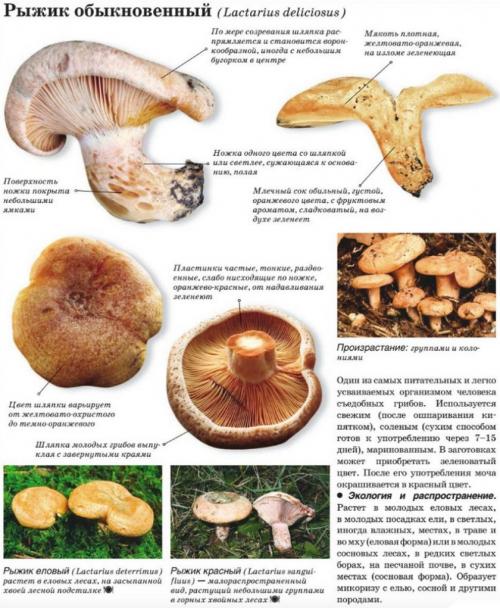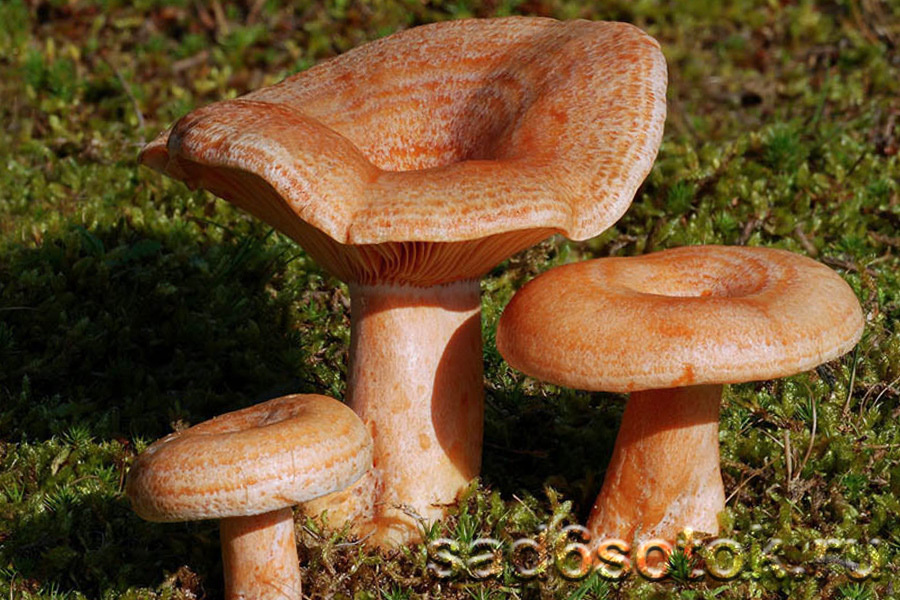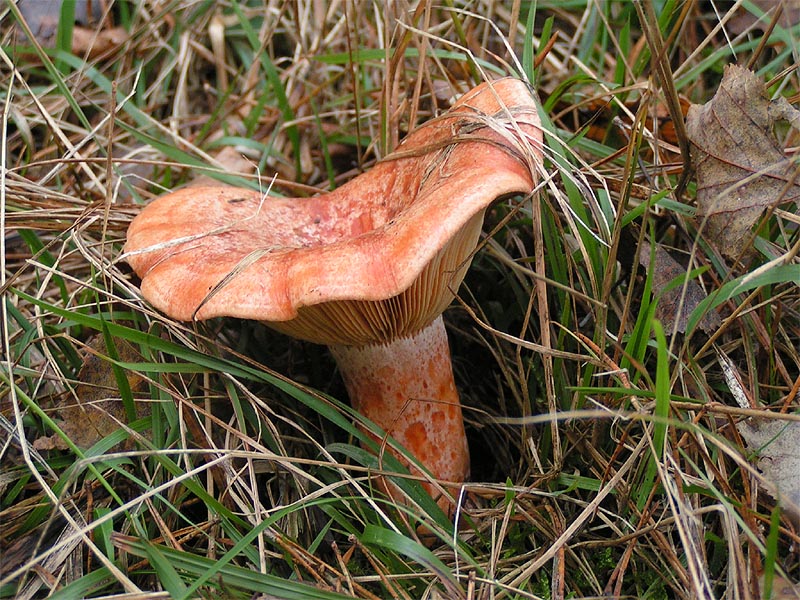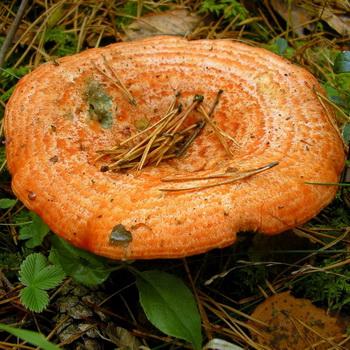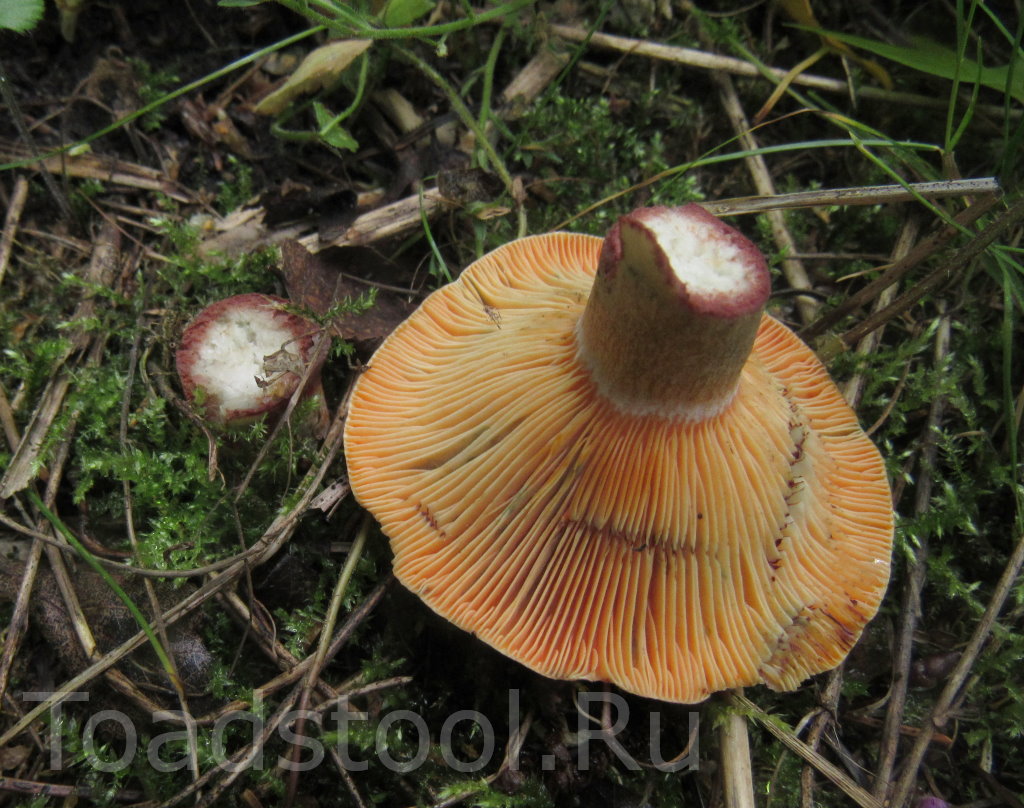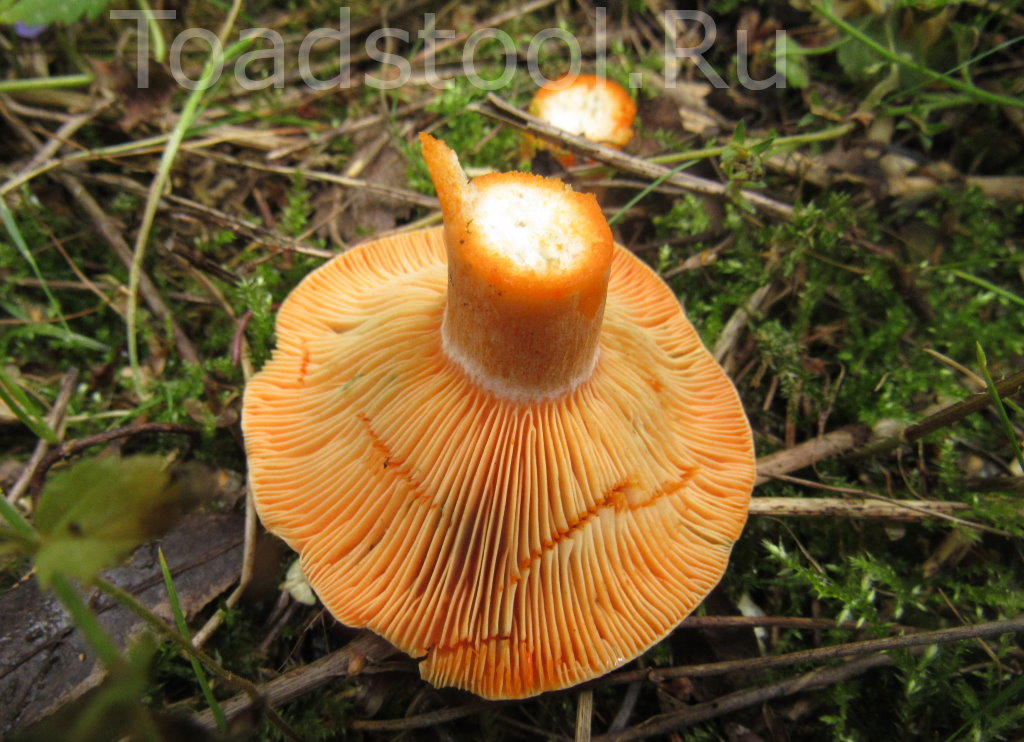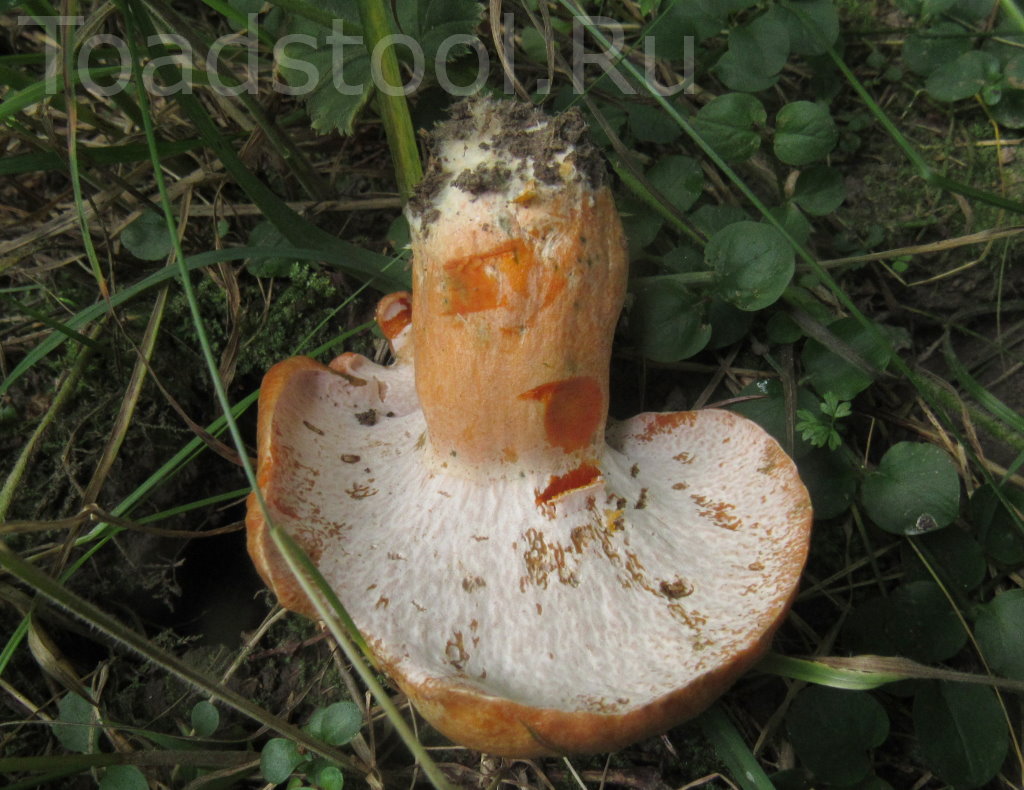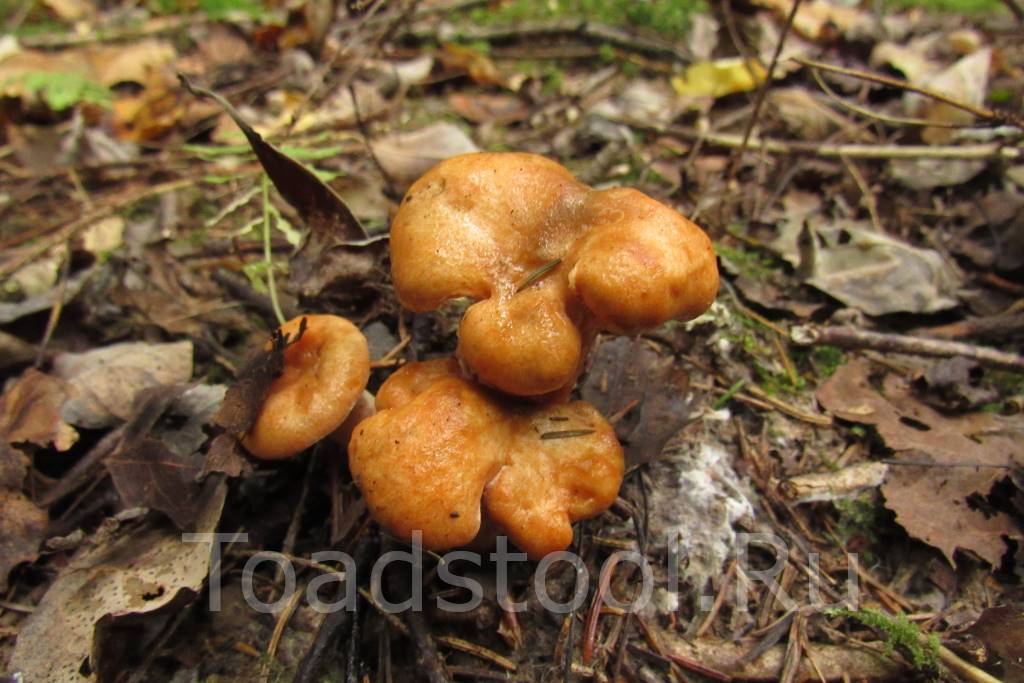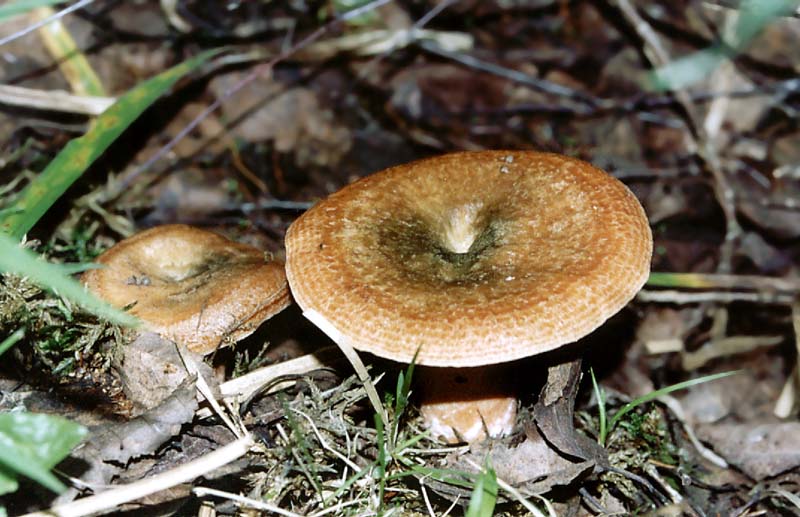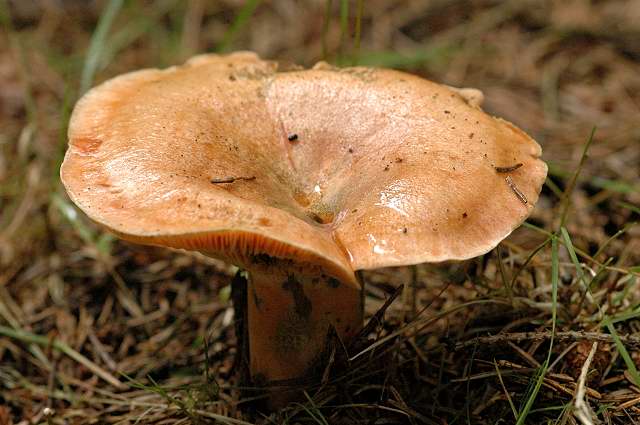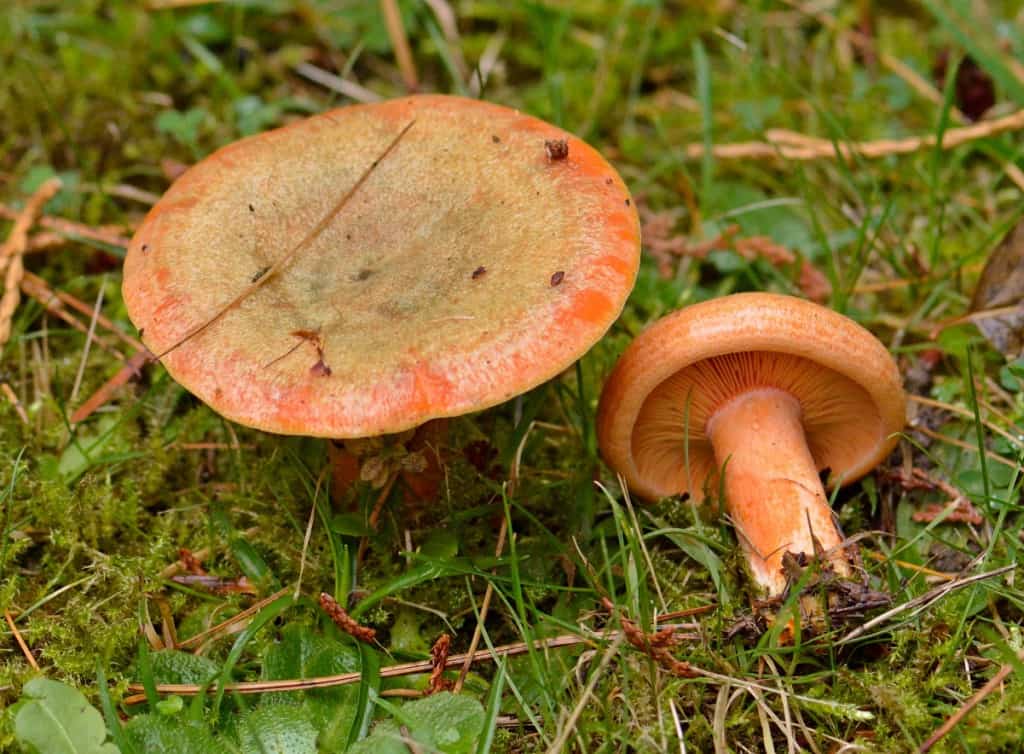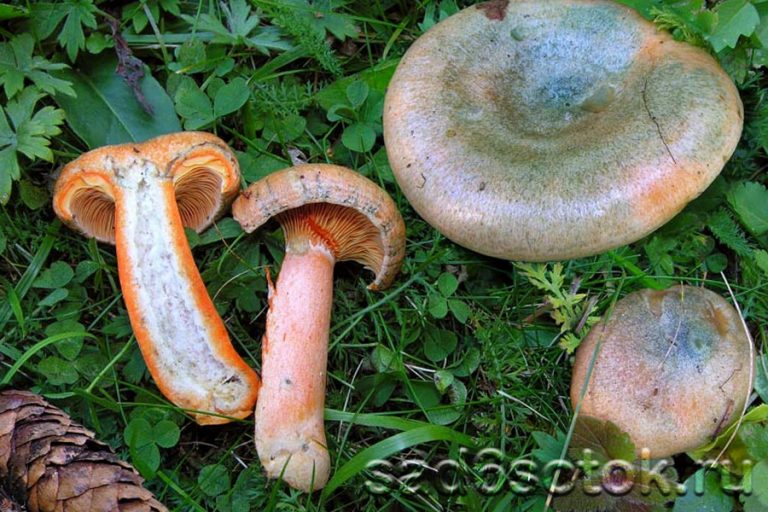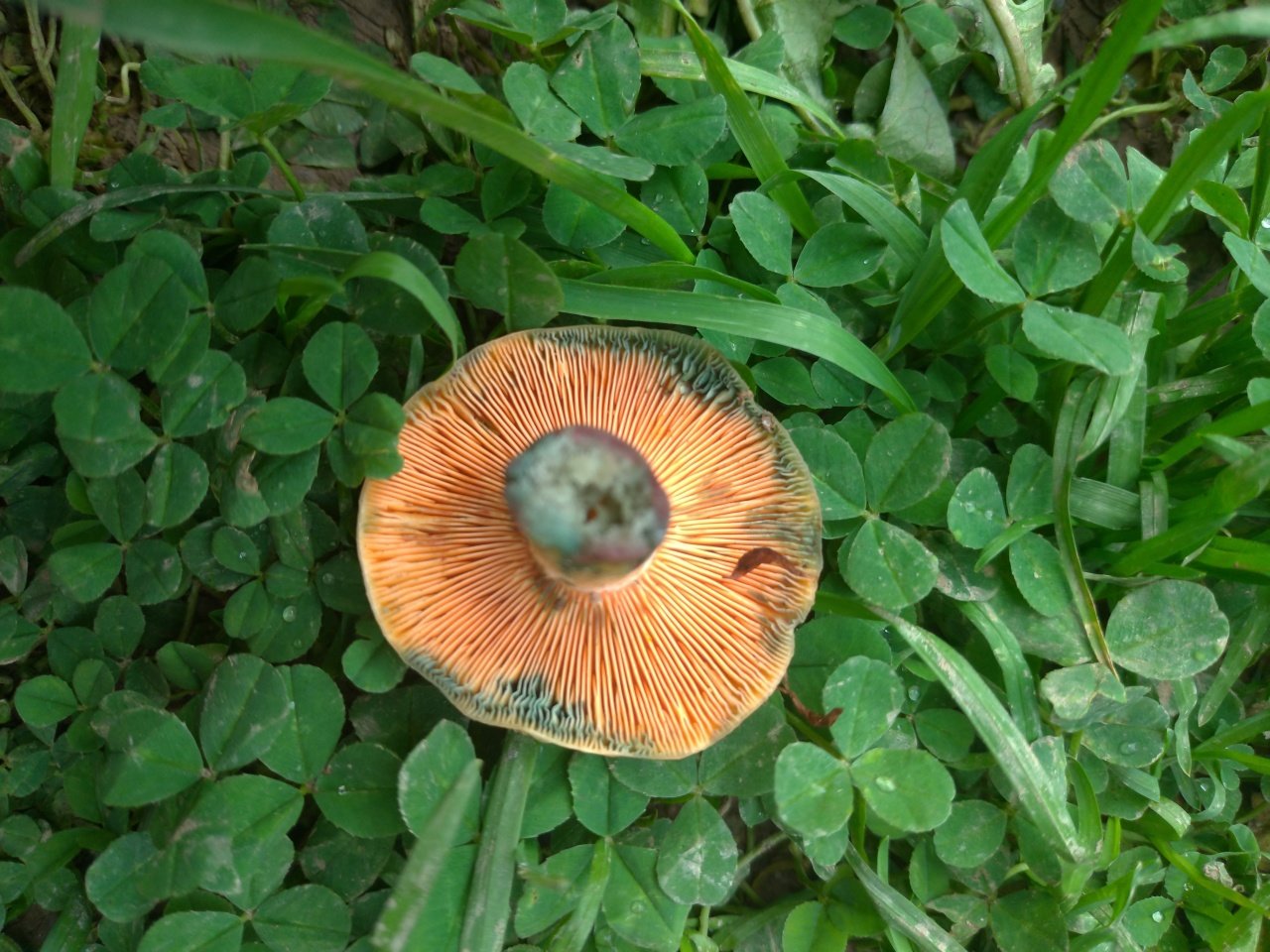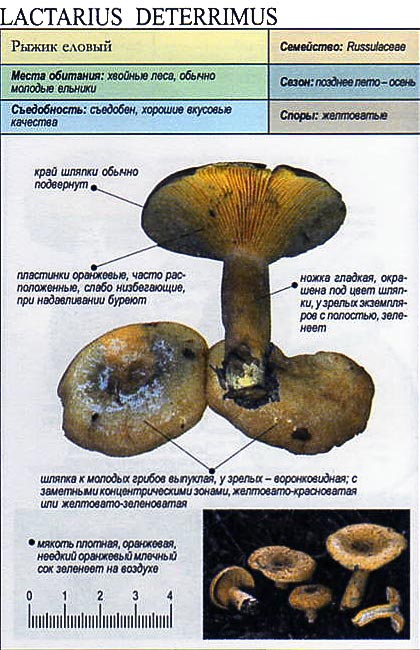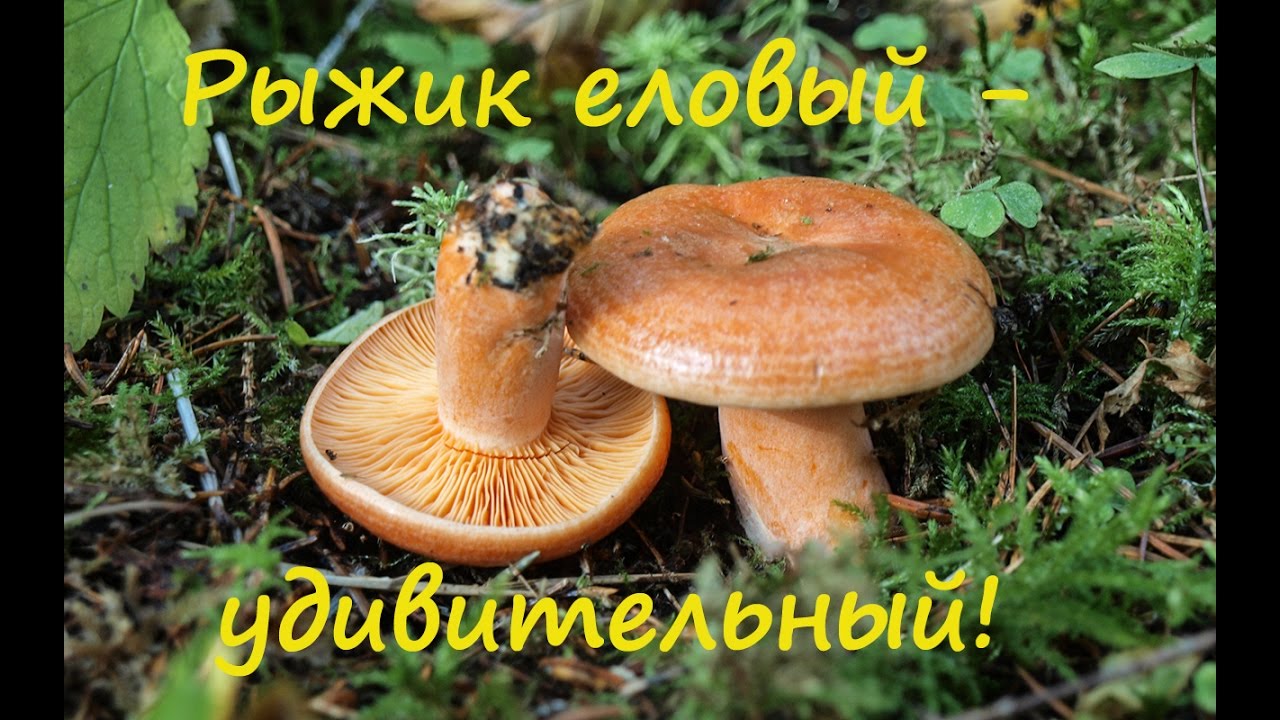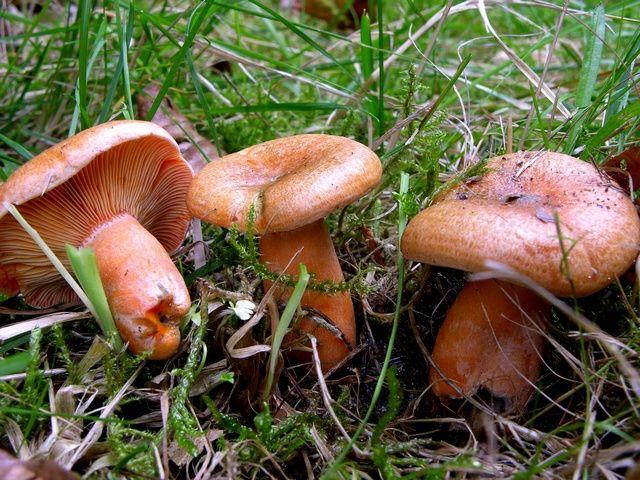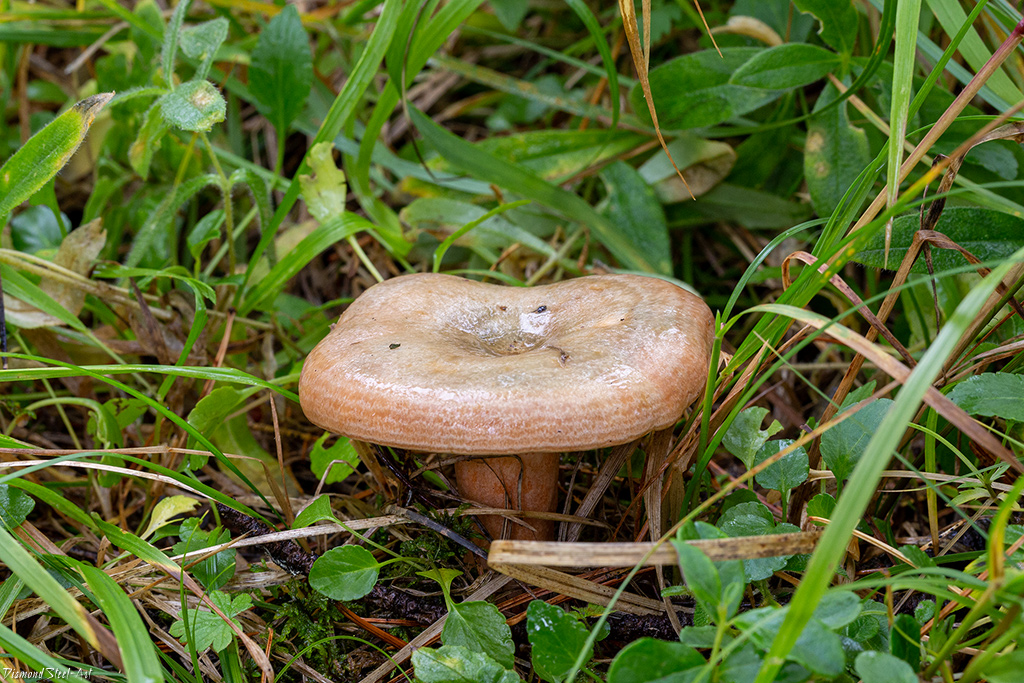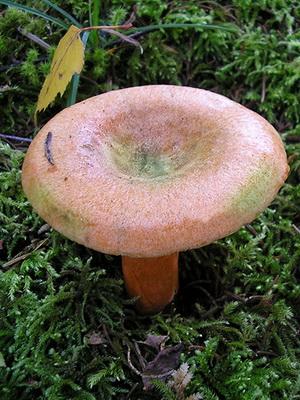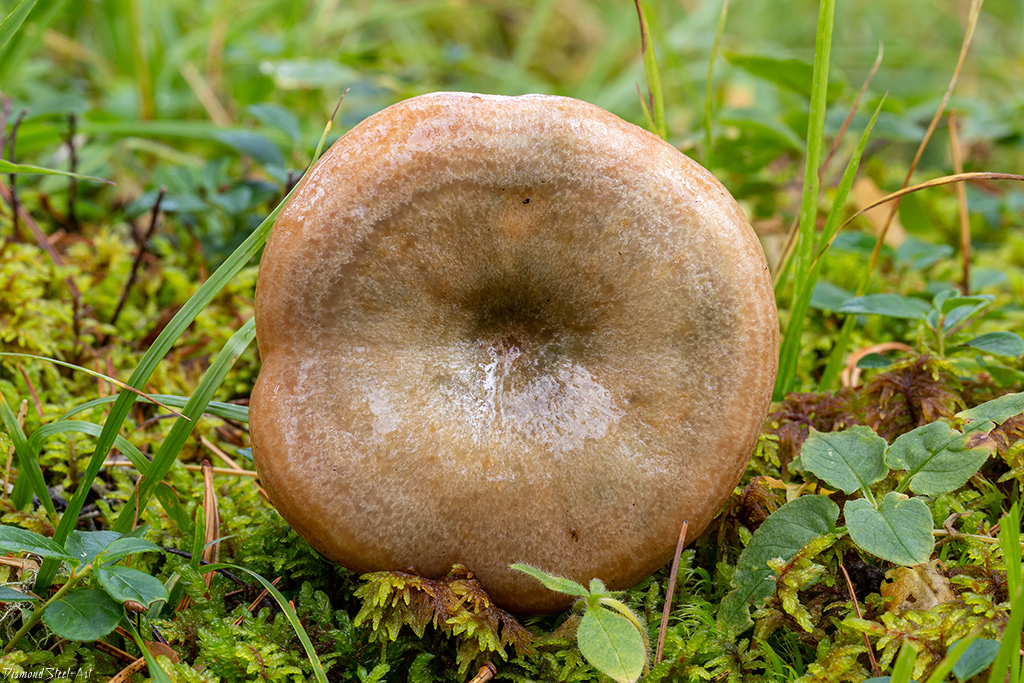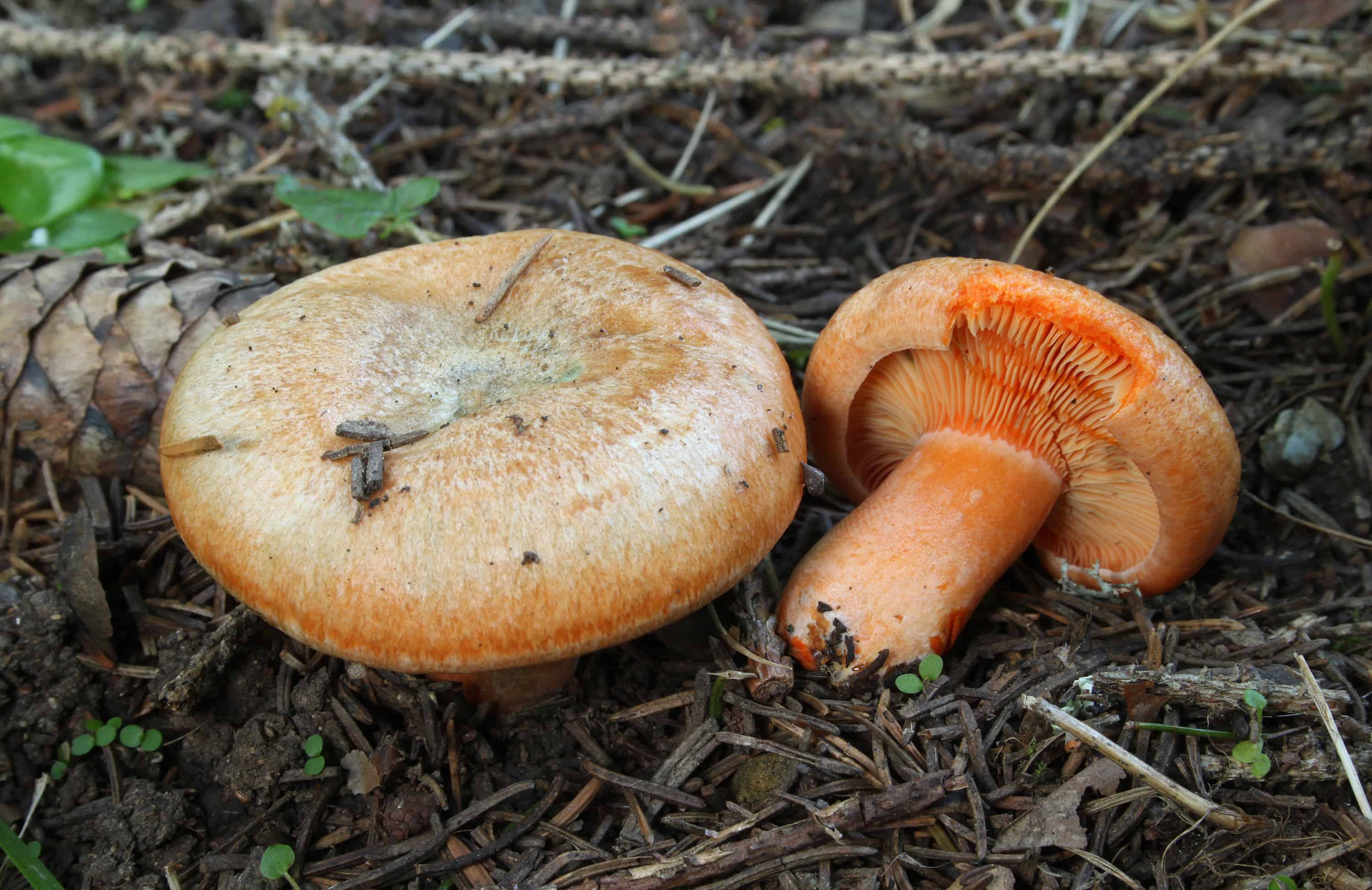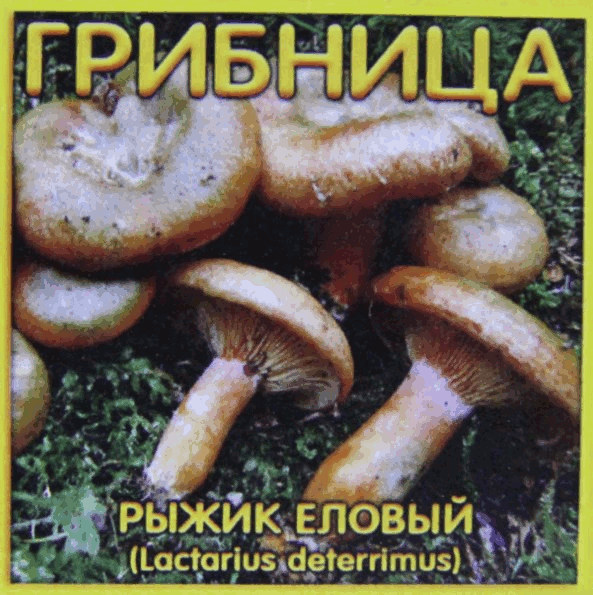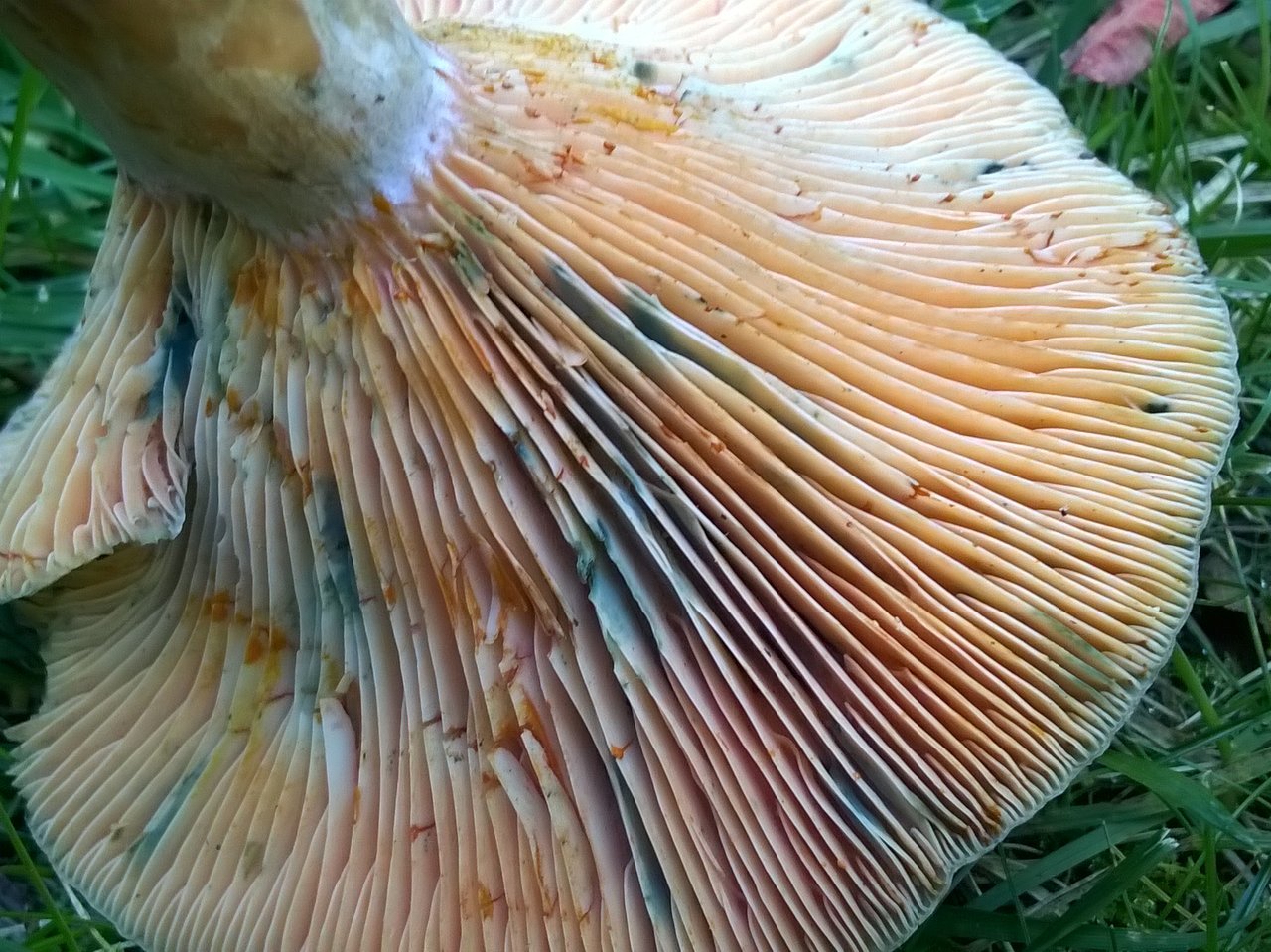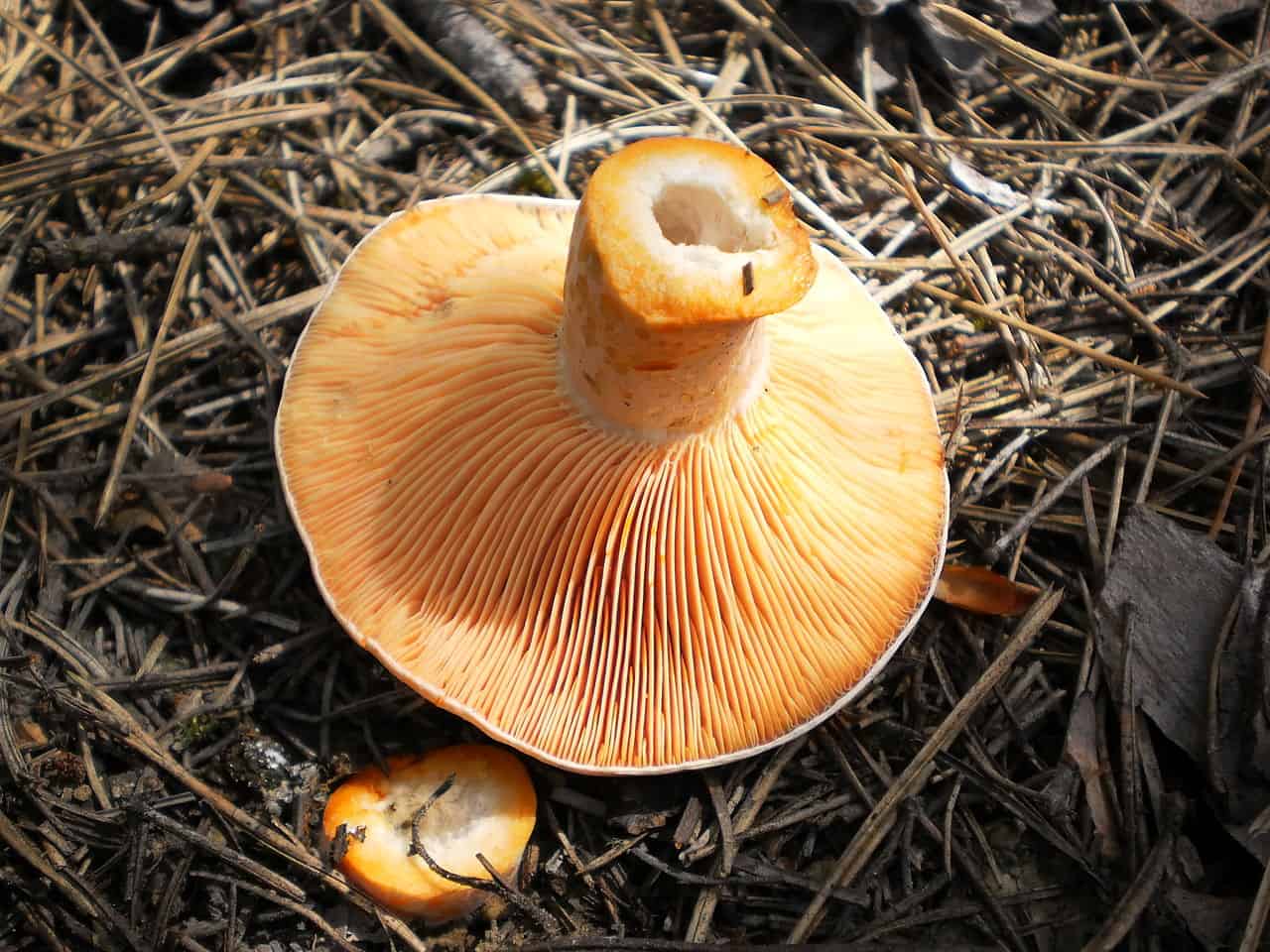Photo and description of pine mushroom:
Pine mushroom (Lactarius deliciosus (L.: Fr.) S. F. Gray)
In saffron milk caps, the cap is 5–15 cm in diameter, at first hemispherical, velvety, then convex with a curled edge, convex-outstretched, slightly depressed, with a lowered thin edge, later funnel-shaped with a straight thin edge, reddish-orange, brick-red to gray-red or greyish-olive, with darker distinct annular zones, sticky in wet weather.
The plates are frequent, orange to orange-yellow, slowly turn green when pressed. The pulp is yellow-orange, quickly turns red on the cut, then turns green, with a pleasant taste.
Milky juice is orange- or carrot-red, does not change color in air or gradually becomes grayish-green. Stem 3–7 × 1–2 cm, cylindrical, often with orange depressed spots, turns green when touched.
Distributed throughout the temperate zone of Russia, forms mycorrhiza with pine. It grows on sandy soils in pine forests, on pine edges, in forests with pine, in pine plantations and windbreaks of forest belts, in grass, among mosses.
Fruiting from July to early November.
Skillfully pickled mushrooms have long been considered an exquisite dish not only in Russia, but also abroad. In the Urals, during a large harvest, these mushrooms were salted right in the forest. For this, cedar barrels evaporated with juniper were taken to the forest.
Each mushroom was wiped off with a linen towel and carefully laid in dense rows, sprinkled with coarse salt. According to old recipes, these mushrooms should be salted in an oak bowl without adding spices in order to preserve their unique taste and aroma.
Similar species:
Spruce mushroom (L. deterrimus) has green caps and blades and grows under fir trees. Of the two other outwardly close, but very rare in our saffron milk caps, the fir (or salmon) camelina (L. salmonicolor) is distinguished primarily by the fact that it grows under the fir, and the blood-red camelina (L. sanguifluus) grows under the pines and differs juice of blood-red, not carrot color.
The medicinal properties of saffron milk caps:
The mushroom has the highest vitamin A content among other edible species. Camelina contains 16 amino acids, including 8 irreplaceable ones.
The mushroom has a high content of glutamine (up to 5% of the mass of the fruit body), which explains its highly delicious taste. When grown in submerged culture, pine mushroom mycelium produces a mixture of fatty acids and other bioactive components (chroman-4-one, anophinic acid, 3-hydroxyacetylindole, ergosterol, cyclic dipeptides, etc.).
Back in the USSR, the antibiotic drug "Lactaroviolin" was obtained from camelina, which has antibacterial properties, antioxidant activity and inhibits the growth of tubercle bacilli.
Methanol extract of fresh fruit bodies has antibacterial and antifungal effects, suppressing Escherichia coli, Micrococcus luteus, Staphylococcus aureus, Salmonella thyphi, Klebsiella pneumoniae, Pseudomonas aeruginosa, Corynebacterium Candaterium, Smeaterium Smeaterium, Bacillus ceregiaceres, B.
It was found that the antimicrobial effect of 500 μg of juice from fresh fruit bodies is equivalent to the action of 10 μg of penicillin.
The antioxidant effect of methanol extract of camelina is similar to that of the widely used α-tocopherol.
Due to the presence of polysaccharides and tyrosinase enzyme, which neutralize the process of fat oxidation in the body, the fungus normalizes metabolism and has a therapeutic effect in case of its violation.
An antitumor effect is also characteristic of the fungus (it inhibits the growth and development of sarcoma-180 and Ehrlich's carcinoma).
The most delicious of the saffron milk caps and, accordingly, of all the milkmen. Used for frying, salting and pickling. As an appetizer for vodka, it is used raw (sprinkled with salt). These mushrooms are salted without soaking, only clearing them of forest debris.
Types of camelina mushrooms: pine, real (delicious) and spruce
Pine mushroom grows in young sparse pine forests, in pine and larch plantations. It is often found and abundantly in favorable years, from June to November, until the very frosts. Grows singly, but more often in groups in sunny, bright places.
The cap is orange-red, reaching 12–17 cm in diameter, with concentric, darker orange stripes, round-convex in young mushrooms, wide-funnel-shaped in grown ones, fades with age, its edges are first tucked inward, then straight. The pulp is dense, fleshy, orange, brittle, fresh in taste, turns green at the break. Milky juice is abundant, orange-yellow, not pungent, with a resinous odor, turns green in the air.
The plates adherent to the stem, yellow-orange, turn green when pressed. The leg is short, cylindrical, of the same color as the cap; if damaged, it also turns green. The pulp inside the leg is white.
Edible, first category. One of the most delicious mushrooms, it is used for pickling, canning, pickling, it can also be boiled and fried. Salted mushrooms retain their color. It is best to salt them cold, without soaking or rinsing. Both hats and legs are used for food.
Gingerbread is real, or gourmet - edible mushroom. The cap is fleshy, 4-12 cm, smooth, convex, later flattened or slightly depressed, orange, brick-red with well-defined concentric zones. The plates are weakly descending along the stem, orange-red, turn green from pressure. Leg 3-7 cm long, 1-3 cm thick, dense, hollow, cap color. The milky juice is orange, plentiful, with a pleasant taste.
Delicious camelina grows in mixed and coniferous forests, but grows abundantly in early autumn in pine groves and in the self-seeding zone of pines in fields and on roadsides. Forms mycorrhiza with pine.
Occurs from August to October.
According to the description, this type of camelina mushrooms is not similar to any of the poisonous mushrooms.
Gingerbread is edible even raw. One of the best edible mushrooms for pickling, pickling and for preparing any other mushroom dishes.
Spruce mushroom (Lactarius deterrimus Groger) is an edible mushroom. The cap is fleshy, 3-8 cm, smooth, convex, later flattened or slightly depressed, orange, fleshy, sometimes with green spots, well-defined concentric zones. The plates are weakly descending along the leg, orange-red, turn yellow from pressure. Leg 3-7 cm long, 1-3 cm thick, dense, hollow, cap color. The milky juice is orange, plentiful, with a pleasant taste, but causes a scratching sensation in the throat. The pulp is brittle, friable, bright orange at the break, then turning green, with carrot-red milky juice, which turns wine red, then greenish. The pulp is dense, well cut with a knife.
It grows in mixed and coniferous forests, but bears fruit abundantly in early autumn in pine groves and in the self-seeding zone of pines in the fields. Spruce mushroom forms mycorrhiza with spruce. In Russia, it was he who was transplanted into the manor estates in the century before last. Occurs from August to September.
Under favorable conditions (not a hot, humid summer), it can bear fruit in 5-6 days after picking the mushrooms several times in a row. It has no poisonous counterparts.
Cooking. Fried are good, and salty ones have an extraordinary taste. When salted, they do not require boiling; they do not put any dill, garlic, or other seasonings in them. Only mushrooms and salt. It turns out to be an excellent delicacy.
Types of saffron milk caps and where they grow
There are several varieties of saffron milk caps that you can find in the forest and put in your basket.
Gingerbread (Lactarius deliciosus)

This species is also called pine or upland. Grows in pine forests, spruce and mixed forests. More often found in growing groups. You can find mushrooms in grass and moss. The fruit body is red-orange in color. The leg is strong. The hat reaches 18 cm in diameter, the color is orange-yellow. In young mushrooms, it is convex, subsequently the edges rise and something like a funnel turns out. The top is smooth and shiny. After rain, it becomes sticky. The leg reaches 2 cm in diameter and up to 7 cm in height. On the cut, it turns green. The milky juice is thick and plentiful and has an orange color. It tastes a little sweet.
Spruce mushroom (Lactarius deterrimus)
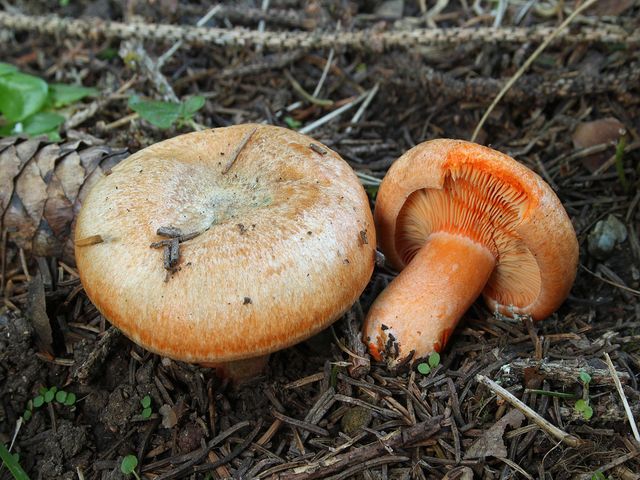
It got its name due to the fact that it grows mainly in spruce forests, forming mycorrhiza with spruce roots. The cap, in comparison with the usual saffron milk cap, is slightly smaller, in diameter only up to 8 cm. Its color is light orange, eventually turns dark green. In those mushrooms that do not grow in the shade but under the sun, the cap can fade and acquire a colorless shade. In wet weather, like in the previous species, it becomes slippery. Because of this, many, especially novice mushroom pickers, mistake them for boletus.
The leg of the mushroom is high and thin: it reaches 7 cm in height and up to 1.5 cm in thickness. Therefore, it is very fragile and often wrinkles and breaks in baskets, buckets, bags of mushroom pickers.
Milky sap is released abundantly, has a reddish tint. It tastes good with a fruity aroma. This species is well suited for salting.
Red mushroom (Lactarius sanguifluus)
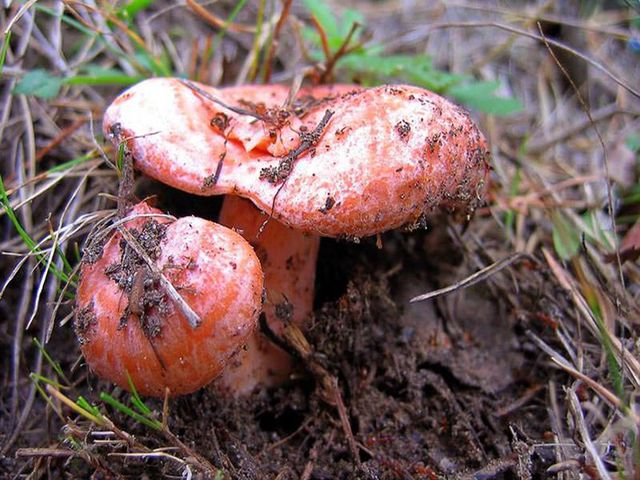
The species is quite rare in comparison with the previous ones. It grows in coniferous forests, both pine and spruce, but mostly in mountainous regions. Occurs in groups of several. The hat is dense, reddish in color with an orange or pinkish tint, hence the name. The diameter of the cap is 10 cm, the edges are slightly bent inward, there is a small depression in the middle. It differs from other species in the absence of mucus.
The leg of this species is strong, reaching a height of 6 cm. Towards the base, it tapers slightly and is covered with a mealy bloom. The color of the leg is mainly yellow-orange, but it can also be purple.
The milky juice in this species of camelina is red in color, but over time it becomes darker in color.
In cooking, this type is used for salting and in the preparation of mushroom dishes.
Japanese Gingerbread (Lactarius japonicus)

The fungus grows in coniferous and deciduous forests in the south of Primorye. It is most common in Japan. Most of all, it can be found under a fir.
The hat is medium-sized, up to 8 cm in diameter. While the mushroom is young, it is flat, with a small depression in the center. The edges of the cap are bent inward. However, this is a common feature of all types of saffron milk caps. Subsequently, the edges of the cap straighten and rise to the top, forming a funnel. The color of the cap is ocher-pinkish, maybe light brown.
The leg reaches a height of 8 cm and 2 cm in diameter. It is hollow inside, and as a result it is very brittle. The pulp is orange in color. Unlike other species, it does not turn green on the cut. The milky juice is red and has a fresh taste.
Milky red mushroom (Lactarius semisanguifluus)
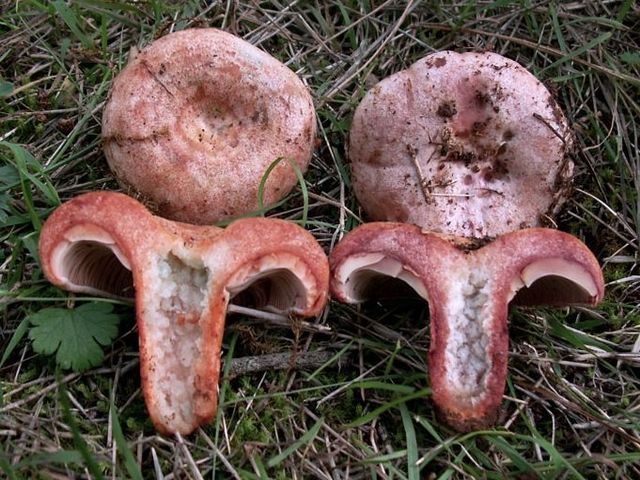
The species is also called simply - red mushroom. It grows mainly in pine forests. The cap is small, reaching 9 cm in diameter. There is a small depression in the center, the edges are bent. The color of the cap is light orange, the plates are the same in color. However, in the old mushroom, they turn red.
The stem of the mushroom reaches 7 cm in height, narrow, hollow inside. Therefore, it is very fragile.
The milky sap is orange in color, but on the cut it gradually turns red, and then completely turns green. Its taste is fragrant.
Despite the fact that there are not so many types of saffron milk caps, they have many twins, among which there are conditionally edible and poisonous ones.
Twin species of saffron milk caps
One of these types is a pink wave. It is found in deciduous forests and often in birch forests. The hat is pinkish, its edges are fringed and slightly curled down. White pulp and milky juice.

Volnushka is conditionally edible; many mushroom pickers prefer to collect this mushroom. It works well for pickling. However, if the salting is less than 45 days, then eating such mushrooms can cause intestinal upset.
Another mushroom that inexperienced mushroom pickers may confuse with camelina is a large lactoser or a papillary milk mushroom.

Grows in coniferous forests. The hat is dry and has a brownish tint. Milky sap is white, does not darken on cut. For use in food, it is necessary to soak or salt for a long time.
Ginger Real Lactarius Deliciosus

Ryzhiki - royal mushrooms of the Russian forest
A wonderful edible mushroom belonging to the first food category. Also known as Pine Ginger.
Appearance
A hat with a diameter of up to 15 cm, initially flat, then funnel-shaped, with edges wrapped inward. Has a smooth and slightly slimy surface. The color of the surface depends on the variety, in Borovye Ryzhiks it is red or light orange in color, with darker concentric circles. In Spruce Ryzhiks, it is orange with a noticeable bluish-green tint, and similar concentric circles. When touched, the cap can turn greenish-blue.
The hymenophore is lamellar, the plates are narrow and frequent, weakly descending on the pedicle, or notched, sometimes have ramifications. Painted in yellow-orange shades, they turn green when pressed.
The leg is up to 6 cm high and up to 2 cm in diameter, cylindrical in shape. It is similar in color to the cap, sometimes covered with reddish pits.
Flesh, brittle, orange or yellowish. At the cut, it first turns red and then turns green. It emits a non-burning bright orange milky juice that smells of resin and has a sour-sweet taste. Freezing in the air, the juice turns grayish-green.
The pulp itself has a pleasant fruity aroma and a pungent aftertaste.
Where and when it grows
Ryzhiks are ubiquitous in coniferous and mixed forests of the central part of Russia, in the Urals and in Siberia. Fruiting from late June to mid-October, young spruce thickets are especially fond of.
Culinary application
Common mushroom is an excellent edible mushroom, suitable for any kind of culinary use, except for drying. Gingerbread is good fried, but most often it is customary to pickle or salt it. When salted, these mushrooms often turn green or even turn black, which does not affect their taste in any way.
What mushrooms look like and when to collect them (with photo)
All types of camelina mushrooms grow in coniferous forests - spruce and pine. It can be found more often in illuminated areas, forest edges, glades, in a young forest, in clearings, in elevated places, on the sides of forest roads. Where mushrooms grow, there is almost always sandy soil. They settle in groups, they can form a "witch's circle". In our country, it is common in the central and northern regions. Ryzhik can be found in the center of the European part of Russia, in the Urals, the Far East, in Siberia. Camelina begins to bear fruit in June and ends in October.
On this page, you will learn what mushrooms look like, when to pick them and how to grow them yourself.
Ginger is easily identifiable. It got its name from the orange color of the cap, plates and legs. The same color and pulp. At the break, the appearance of an orange milky juice, which begins to turn green in the air, is characteristic. The plates on the back of the cap also turn green in crushed places and tears. The cap of a young mushroom is convex, and then funnel-shaped, reaches a diameter of 10-12 cm, the leg is rather short 1-2 cm, hollow inside. The color of the cap is characterized by concentric zoning, alternation of light and dark colored stripes, sometimes with an admixture of greenish color. It is unlikely that in any other mushroom you can find such an abundance of characteristic features that make it possible to accurately identify this mushroom.
The cap of the forest mushroom of the camelina is 4 to 17 cm in diameter, in the middle there is a funnel-shaped depression, from which concentric circles extend. The most "red" saffron milk caps - with a grayish-orange cap - grow in pine forests. In spruce forests, mushrooms are colored more modestly, their caps are bluish-greenish with yellow-orange circles. Mushroom pickers noticed that in a rainy summer there are more spruce mushrooms, and in a dry - pine.
Camelina usually grows in the second half of the year. Most abundant in the second half of September - the first half of October. Single finds occur throughout November. I had to meet him after the first frost on the soil. As for when to pick mushrooms for mushrooms, there is a saying: "Summer mushroom is not suitable for serious business, only in hot weather, but autumn mushroom is good for everyone and is good in all kinds."
The mushroom usually grows in groups (families). Each family consists of specimens of different ages, most of which are hidden under moss or in dense grass, and the most adults can be seen from a height of human growth. Therefore, if you have already sat down to put the noticed mushroom in the basket, take a closer look, part the grass, throw aside the fallen leaves, and you will definitely find several more solar discs, one smaller than the other.
By the saffron milk caps, you can determine the cardinal points. Most of these mushrooms grow from the northern side of the trees.
The mushrooms can only be confused with the mushrooms, but the flesh of the bellies is white or pale pink, and the whole mushroom is much lighter than the mushroom. Although it is with saffron milk caps that waves are most often found.
These photos show how mushrooms look like:

In the photo there is an edible mushroom "Pine Ginger"

Delicious mushroom in the photo

In the photo there is an edible mushroom "Spruce ginger"
Harm from saffron milk caps
Any product, whatever it may be, in addition to useful properties, can also have harmful ones. True, most often these harmful qualities apply only to a certain circle of people. It turns out that one can use this or that product, while others cannot. If it comes to that matter, then the fly agaric may turn out to be dangerous for someone, but not for someone. Also with mushrooms.
Since these mushrooms are very nutritious, due to the large amount of proteins, this becomes an important point for those people who have kidney or liver disease. In addition, it is worth refraining from excessive consumption of saffron milk caps for those who are obese.
There are contraindications for the use of saffron milk caps and those who have inflammation of the pancreas or gallbladder, lack of bile secretion, gastritis, low acidity of gastric juice.

There are some more features of the use of saffron milk caps. If they are neglected, then there can be trouble.
Firstly, if you do not know whether the mushrooms will be useful to you or not, then after using them, you suddenly have weakness and problems with digestion, you need to immediately clear your stomach. Themselves should exclude mushrooms from their diet.
You should not combine mushrooms with cabbage. It will be very difficult for the stomach to digest all this. Also, do not combine with foods that are very high in vitamin A. This can lead to an allergic reaction. It is not recommended to eat mushrooms for young children and pregnant women.
Most often, mushrooms are salted or pickled. It should be remembered that there are practically no useful substances in salted mushrooms, but they are stored for a very long time, without loss of taste. Pickled mushrooms have the same calorie content as marinade. Therefore, excessive consumption of such a product can lead to excess weight. The only way these mushrooms do not lose their beneficial properties or taste is frozen and dry.
And the last one. This is more a matter of picking mushrooms. Since it was said earlier that the saffron milk caps have twins, among which the amber milky contains some poisonous substances, poisoning is possible if you confuse these mushrooms.
Symptoms of poisoning include fever, abdominal cramps, gag reflex and loose stools.
If this trouble happens, don't panic. It is recommended to drink plenty of water and call an ambulance immediately.
However, it is best to pick pre-known mushrooms. If in doubt, it is better not to touch the mushroom. Well, those that have been collected must be double-checked and the best ones selected, without damage.
Since mushrooms are a food product, it goes without saying that the question arises as to what and how can be prepared from them.
Preparation
There are many recipes for cooking mushroom dishes from camelina, but in most cases they prefer to salt or pickle
Pay attention to several successful options for how to cook mushrooms at home so that they retain useful substances and trace elements
Salting
If a large crop of camelina has been harvested, they can be cold salted. Such preparation does not involve the use of vinegar, so the appetizer turns out to be not only royally tasty, but also healthy.
Ingredients:
- 1 kg of fresh mushrooms;
- 40 g salt;
- currant and laurel leaves;
- allspice and black peppercorns to taste.
Preparation:
- Put the peeled mushrooms on a sieve and pour over boiling water twice. Then they are washed with cold water and allowed to dry.
- Salt mixed with spices is placed on the bottom of a wooden barrel or enamel container.
- Next, spread the mushrooms, placing them with their caps up. The thickness of each row is no more than 7 cm. The layers are sprinkled with salt and pepper.
- The remaining spices are placed on top.
- The workpiece is covered with a clean towel, a wooden circle is placed on top and oppression is placed.
- The container is taken out to a cool place.
- After a few days, the brine will appear. It must be drained periodically.
The mushrooms will be ready to eat in one to two months. In the future, they can be transferred to jars and stored under an airtight lid in the refrigerator.
Fried mushrooms
Ryzhiks can not only be salted, but also fried. A simple recipe loved by many - with onions and sour cream. Chanterelles are prepared in a similar way.
Products:
- 0.5 kg of mushrooms;
- 2 medium onions;
- 200 g sour cream;
- vegetable oil for frying;
- salt and pepper to taste.
Cooking step by step:
- Onions are cut into small cubes and fried until golden brown
- The peeled and washed mushrooms are cut into random pieces, lightly doused in flour and fried separately.
- Mix onions with mushrooms, add sour cream, salt and pepper.
It is better to serve the dish hot, garnished with fresh herbs.

